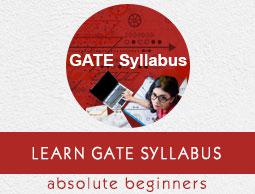GATE Mining Engineering Syllabus
Subject Code: MN
Course Structure
| Sections/Units |
Topics |
| Section A |
Engineering Mathematics |
| Unit 1 |
Linear Algebra |
| Unit 2 |
Calculus |
| Unit 3 |
Vector Calculus |
| Unit 4 |
Differential Equations |
| Unit 5 |
Probability and Statistics |
| Unit 6 |
Numerical Methods |
| Section B |
Mine Development and Surveying |
| Unit 1 |
Mine Development |
| Unit 2 |
Mine Surveying |
| Section C |
Geomechanics and Ground Control |
| Unit 1 |
Engineering Mechanics |
| Unit 2 |
Geomechanics |
| Unit 3 |
Ground Control |
| Section D |
Mining Methods and Machinery |
| Unit 1 |
Mining Methods |
| Unit 2 |
Mining Machinery |
| Section E |
Surface Environment, Mine Ventilation, and Underground Hazards |
| Unit 1 |
Surface Environment |
| Unit 2 |
Mine Ventilation |
| Unit 3 |
Subsurface Hazards |
| Section F |
Mine Economics, Mine Planning, Systems Engineering |
| Unit 1 |
Mine Economics |
| Unit 2 |
Mine Planning |
| Unit 3 |
Systems Engineering |
Course Syllabus
Section A: Engineering Mathematics
Unit 1: Linear Algebra
- Matrices and Determinants
- Systems of linear equations
- Eigen values and Eigen vectors
Unit 2: Calculus
- Limit, continuity and differentiability
- Partial Derivatives
- Maxima and minima
- Sequences and series
- Test for convergence
- Fourier series
Unit 3: Vector Calculus
- Gradient
- Divergence and Curl
- Line
- Surface and volume
- Integrals
- Stokes, Gauss and Green’s theorems
Unit 4: Differential Equations
- Linear and non-linear first order ODEs
- Higher order linear ODEs
- with constant coefficients
- Cauchy’s and Euler’s equations
Unit 5: Probability and Statistics
- Measures of central tendency
- Random variables
- Poisson, normal and binomial distributions
- Correlation and regression analysis
Unit 6: Numerical Methods
- Solutions of linear algebraic equations
- Integration of trapezoidal and Simpson’s rule
- Single and multi-step methods for differential equations
Section B: Mine Development and Surveying
Unit 1: Mine Development
- Methods of access to deposits
- Underground drivages
- Drilling methods and machines
- Explosives, blasting devices and practices
Unit 2: Mine Surveying
- Levels and leveling, theodolite, tacheometry and triangulation
- Contouring
- Errors and adjustments
- Correlation
- Underground surveying
- Curves
- Photogrammetry
- Field astronomy
- EDM and Total Station
- Introductory GPS
Section C: Geomechanics and Ground Control
Unit 1: Engineering Mechanics
- Equivalent force systems
- Equations of equilibrium
- Two dimensional frames and trusses
- Free body diagrams
- Friction forces
- Particle kinematics and dynamics
- Beam analysis
Unit 2: Geomechanics
- Geo-technical properties of rocks
- Rock mass classification
- Instrumentation and stress measurement techniques
- Theories of rock failure
- Ground vibrations
- Stress distribution around mine openings
- Subsidence
- Rock bursts and coal bumps
- Slope stability
Unit 3: Ground Control
- Design of pillars
- Roof supporting systems
- Mine filling
Section D: Mining Methods and Machinery
Unit 1: Mining Methods
- Surface mining −
- Layout
- Development
- Loading
- Transportation and mechanization
- Continuous surface mining systems
- Underground coal mining −
- Bord and pillar systems
- Room and pillar mining
- Longwall mining
- Thick seam mining methods
- Highwall mining
- Underground metal mining −
- Open, supported and caved stoping methods
- Stope mechanization
- Ore handling systems
Unit 2: Mining Machinery
- Generation and transmission of mechanical, hydraulic and pneumatic power
- Materials handling −
- Haulages
- Conveyors
- Face and development machinery
- Hoisting systems
- Pumps
- Crushers
Section E: Surface Environment, Mine Ventilation, and Underground Hazards
Unit 1: Surface Environment
- Air, water and soil pollution −
- Standards of quality
- Causes and dispersion of contamination
- Control
- Noise
- Land reclamation
Unit 2: Mine Ventilation
- Underground atmosphere
- Heat load sources and thermal environment, air cooling
- Mechanics of air flow, distribution, natural and mechanical ventilation
- Mine fans and their usage
- Auxiliary ventilation
- Ventilation planning
- Ventilation networks
Unit 3: Subsurface Hazards
- Mine Gases
- Underground hazards from fires, explosions, dust and inundation
- Rescue apparatus and practices
- Safety in mines
- Accident data analysis
- Mine lighting
- Mine legislation
- Occupational safety
Section F: Mine Economics, Mine Planning, Systems Engineering
Unit 1: Mine Economics
- Mineral resource classification
- Discounted cash flow analysis
- Mine valuation
- Mine investment analysis
- Mineral taxation
Unit 2: Mine Planning
- Sampling methods, practices and interpretation
- Reserve estimation techniques −
- Basics of geostatistics and quality control
- Optimization of facility location
- Work-study
Unit 3: Systems Engineering
- Concepts of reliability
- Reliability of simple systems
- Maintainability and availability
- Linear programming, transportation and assignment problems
- Network analysis
- Inventory models
- Queueing theory
- Basics of simulation
To download pdf Click here.


